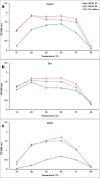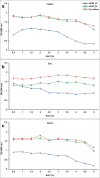Synergistic enhancement of heavy metal tolerance and reduction by indigenous bacterial consortia of Pseudomonas putida and Pasteurella aerogenes
- PMID: 40634562
- PMCID: PMC12241649
- DOI: 10.1038/s41598-025-99238-8
Synergistic enhancement of heavy metal tolerance and reduction by indigenous bacterial consortia of Pseudomonas putida and Pasteurella aerogenes
Abstract
Effective remediation is needed to reduce environmental and health threats from heavy metal contamination. This work examines the bioremediation capability of a new bacterial consortium from the polluted Tanjaro River: Pseudomonas putida pUoR_24 and Pasteurella aerogenes aUoR_24. Research will evaluate the consortium's ability to reduce copper (Cu), zinc (Zn), and nickel (Ni) concentrations in different environments. The study used microbiological methods to investigate metal tolerance, reduction efficiency, and growth optimization at varied temperatures, salinities, and pH levels. Results demonstrate the consortium's superior metal tolerance, with Minimum Inhibitory Concentrations (MICs) of 8 mM for Cu and 7 mM for Ni. Inductively Coupled Plasma Optical Emission Spectrometry (ICP-OES) showed outstanding metal reduction rates of 84.78% for Cu, 91.27% for Zn, and 88.22% for Ni, exceeding those of individual strains. Based on Scanning Electron Microscopy (SEM) and Energy Dispersive X-ray (EDX) analyses, Cu exhibited the highest weight percentage (3.7%), followed by Ni (0.5%), while Zn was undetectable, suggesting preferential sequestration of Cu and Ni by the consortium. The consortium also displayed robust growth across a wide range of temperatures (20-37°C), salinities (up to 4% NaCl), and pH levels (2-11). These findings show that microbial consortia can establish eco-friendly bioremediation solutions for heavy metal-contaminated settings.
Keywords: Pasteurella aerogenes; Pseudomonas putida; Bacterial consortium; Heavy metal bioremediation; Synergistic interactions.
© 2025. The Author(s).
Conflict of interest statement
Declarations. Competing interests: The authors declare no competing interests.
Figures










Similar articles
-
Removal of high concentrations of zinc, cadmium, and nickel heavy metals by Bacillus and Comamonas through microbially induced carbonate precipitation.Biodegradation. 2025 May 5;36(3):40. doi: 10.1007/s10532-025-10131-7. Biodegradation. 2025. PMID: 40323541 Free PMC article.
-
Synergistic effects of indigenous bacterial consortia on heavy metal tolerance and reduction.Environ Geochem Health. 2025 Feb 18;47(3):79. doi: 10.1007/s10653-025-02392-1. Environ Geochem Health. 2025. PMID: 39966180
-
Comparative analysis of Cu(II) and Ni(II) removal using Agaricus bisporus mushroom and spent mushroom compost as biosorbents.Int J Phytoremediation. 2025;27(11):1551-1568. doi: 10.1080/15226514.2025.2509810. Epub 2025 May 29. Int J Phytoremediation. 2025. PMID: 40439291
-
AI-assisted systematic review on remediation of contaminated soils with PAHs and heavy metals.J Hazard Mater. 2024 Apr 15;468:133813. doi: 10.1016/j.jhazmat.2024.133813. Epub 2024 Feb 17. J Hazard Mater. 2024. PMID: 38402679
-
Biological roles of soil microbial consortium on promoting safe crop production in heavy metal(loid) contaminated soil: A systematic review.Sci Total Environ. 2024 Feb 20;912:168994. doi: 10.1016/j.scitotenv.2023.168994. Epub 2023 Dec 2. Sci Total Environ. 2024. PMID: 38043809
References
-
- Ugrina, M. & Jurić, A. Current trends and future perspectives in the remediation of polluted water, soil and air—A review. Processes11, 3270 (2023).
-
- Barawi, S. S. et al. Catalytic synthesis of selenium nanoparticles by gram-negative Aeromonas sobria and their application for removal of toxic dyes. Biologia80, 149–161 (2024).
-
- Hussein, S. H., Qurbani, K., Ahmed, S. K., Tawfeeq, W. & Hassan, M. Bioremediation of heavy metals in contaminated environments using Comamonas species: A narrative review. Bioresour. Technol. Rep.25, 101711 (2024).
-
- Ali, H., Khan, E. & Ilahi, I. Environmental chemistry and ecotoxicology of hazardous heavy metals: Environmental persistence, toxicity, and bioaccumulation. J. Chem.2019, 6730305 (2019).
MeSH terms
Substances
LinkOut - more resources
Full Text Sources

